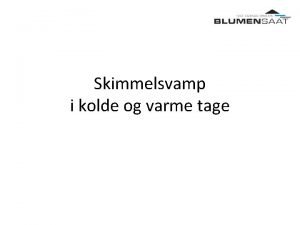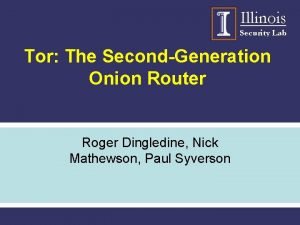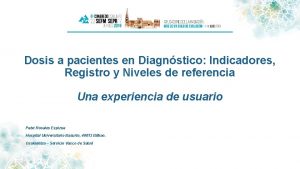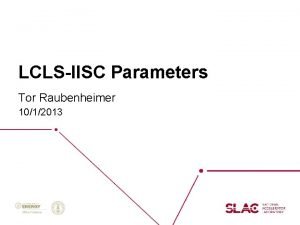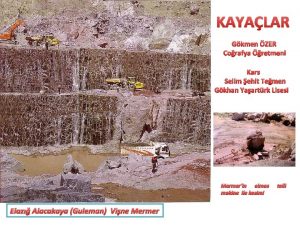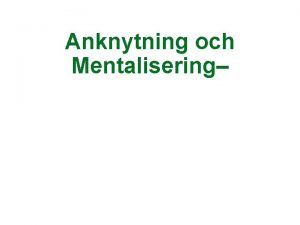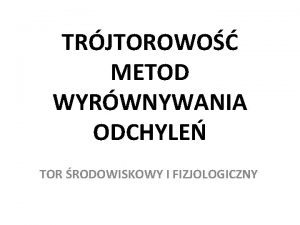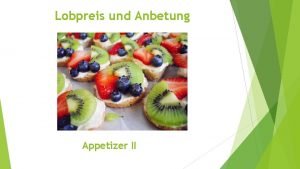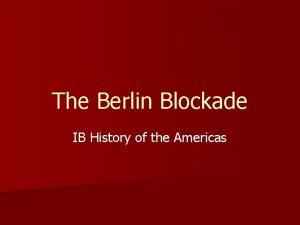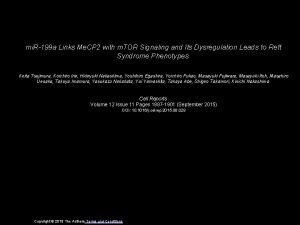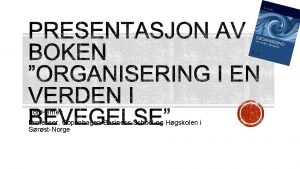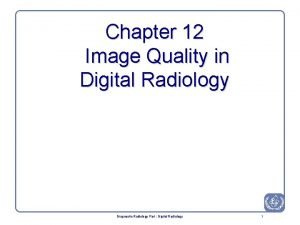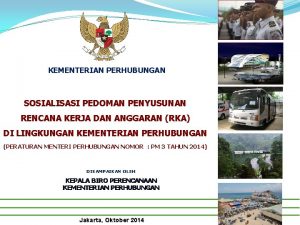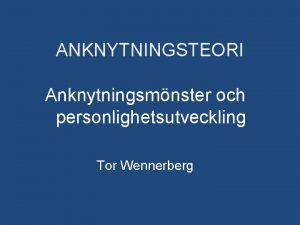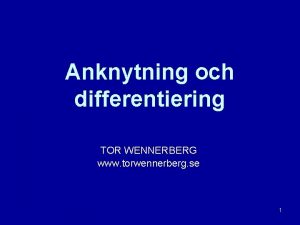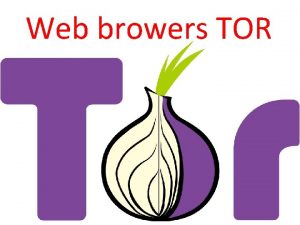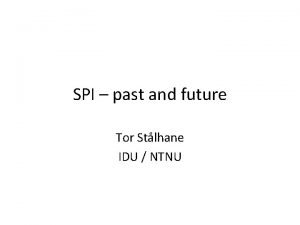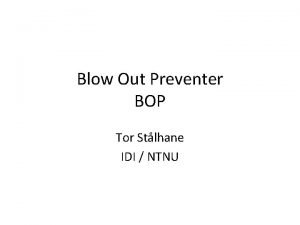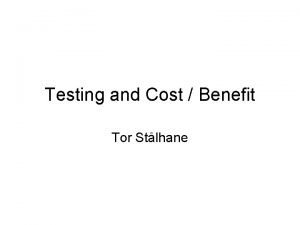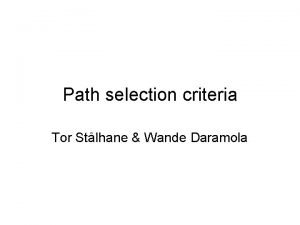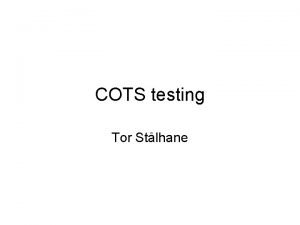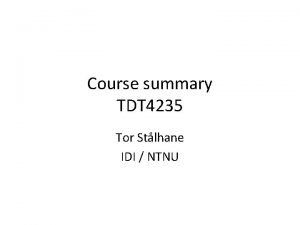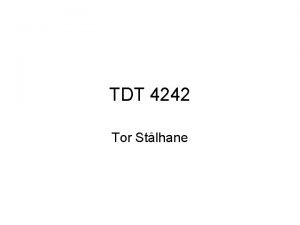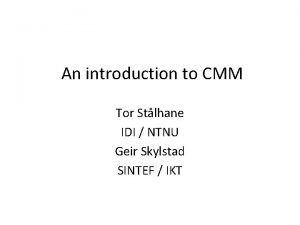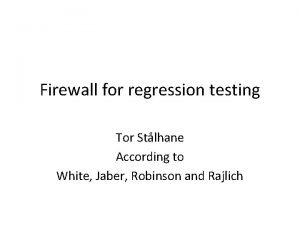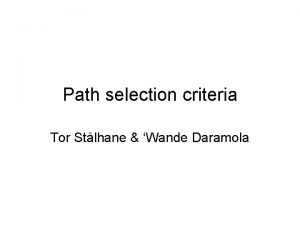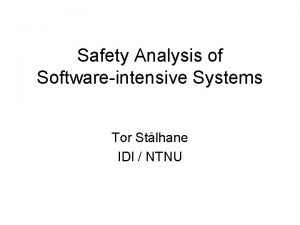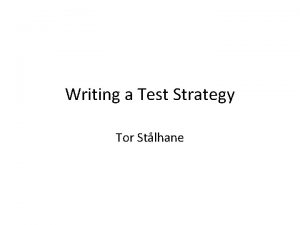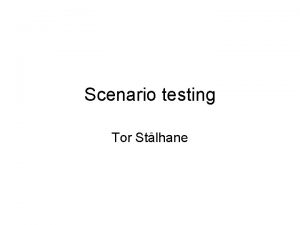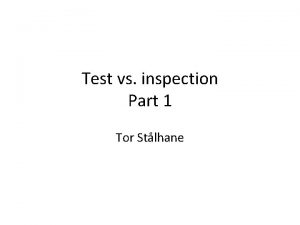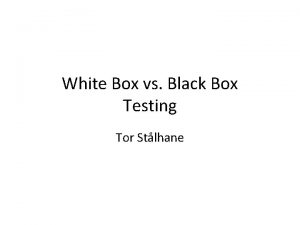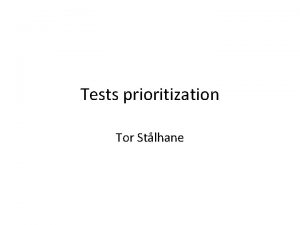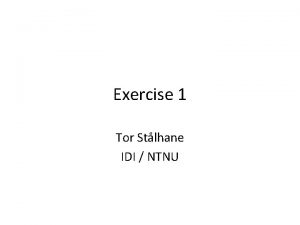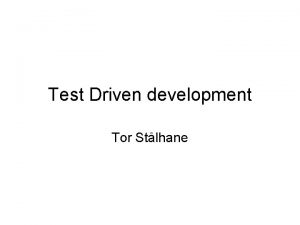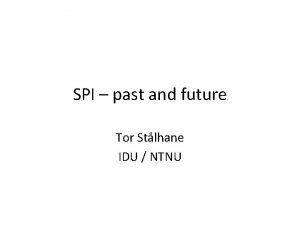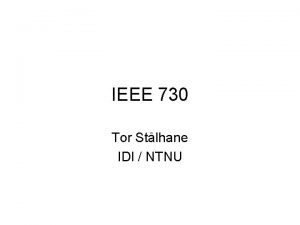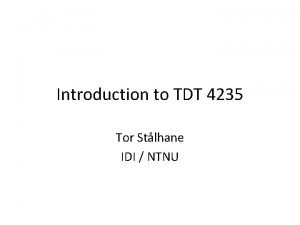To improve or not to improve Tor Stlhane



























- Slides: 27

To improve or not to improve Tor Stålhane IDI / NTNU

The ESPINODE European survey Data was collected through an e-mail questionnaire. Country Do SPI Iceland 15 Don’t do SPI 5 Greece 15 10 Italy 9 14 Ireland 14 1 Scandinavia 13 1 Sum 66 31

Those who do SPI • What are the most important contributions of SPI? A total of 74% of the answers fall into one of the three categories. – Better process – 30% – Improved quality – 25% – Obtain business benefits – 19% • Most important challenges for the future. A total of 83% of the answers fall into one of the three categories. – Improve development efficiency - 36% – Increase customer satisfaction – 24% – Promote company growth – 23% • Help needed. A total of 84% of the answers fall into one of the three categories. – Seminars, networking and related events – 37% – Consultancy – 27% – Better tools and methods – 20%

Those who don’t do SPI • What are the most important reasons for not doing SPI? A total of 70% of the answers fall into one of the two categories. – Do not have resources available – 40% – Cost too much – 30% • Most important challenges for the future. A total of 74% of the answers fall into one of the three categories. – Increase customer satisfaction – 29% – Be more innovative – 26% – Promote company growth – 19% • Help needed. A total of 80% of the answers fall into one of the four categories. – – Consultancy – 24% Networking – 24% Formative help – 18% Financial help – 14%

How are these companies equal? Both groups (47% and 48%) prioritized: – Increase customer satisfaction – Promote company growth • Both groups (64% and 48%) needed – Seminars, networking and related events – Consultancy

Summary Do SPI Small companies Balance time and cost Quality of products Increase number of products Decrease costs Internet applications Introduce new systems Project augmentations Do not do SPI Internet Software for home appliances (long) distance working Lower costs Better quality Increase number of customers Improve know-how Keep up with economic changes Competition Large companies Process management Quantitative management Competence development Competition New environments Fast implementation of new products Low maintenance costs Information intensive applications New development methods and new standards Electronic commerce Successful project management

Four improvement goals • Cost reduction – constant output, reduced input. => SPI through “Mean and lean”. • Controlled growth – large increase in output, smaller increase in input. => SPI through investment, e. g. buy a new tool. • Work smarter – increased output, constant input. => SPI through better ways to do things. • Work more efficient – increase output, decrease input. => SPI by e. g. , reducing rework

Evolution vs. revolution Evolution Revolution Quality view Problem to solve - a necessity Ideal function to be achieved – an opportunity Motive Eliminate complaints Elicit compliments Step Inspect SPC Focus Discover Control Method Measure Statistical technique Responsible Inspector Production Result QA Strategic quality management Avoid Listen to the voice of the mistakes customers Programs and QFD System Robust systems approach design Production, development Earn right to sell Keep market shares Everyone Command higher price Gain market share

Time frame and stability Environment stability Low Risk management CMM Mean and lean Medium We are moving this way Measurement based SPI High Short Medium Long Company time frame

Setting goals Company beliefs • market changes • customer image • Company plans Select improvement goals What shall we improve Risk profile How shall we improve Select improvement approach Management goals Environment Customers Owner goals

PDCA We have seen the PDCA wheel earlier. We have added an extra wheel that may be needed before and during the planning session

The Quality Improvement Paradigm – 1 The PDCA is quite general. We can get more insight by using the Quality Improvement Paradigm – QIP – as shown on the next slide. • QIP separates – Project learning – what the project staff learns during the project – Organization learning – what the organization as a whole is able to learn from the project. • QIP has more detailes – e. g. “Plan” => – Characterize – Set goals

The Quality Improvement Paradigm – 2 Corporate Learning Package and store experience Analyze results Project Learning Provide process with feedback Characterize and understand Set goals Execute Analyze results Choose processes, methods, tools, and techniques

The Quality Improvement Paradigm – 3 Individual Collective Tacit Personal experience Common sense Explicit Proprietary Open to everybody In the project Transferred

The complete SPI process – 1 There are two ways to look at the SPI process: • An extended and detailed version of the PDCA wheel • The 4 V model We will give a short walkthrough of both.

Detailed PDCA – 1 Plan Act Do Check

Detailed PDCA model – 2 • Analyse current process – flow charts, brain storming and cause and effect diagrams. • Define desired outcome of improved process – brainstorming in addition to such techniques as Pareto analysis. • Identify causes and proposed solutions – brainstorming, Pareto analysis and root cause analysis. • Priorities, plan and test proposed solutions – plotting techniques such as histograms and scatter plots, Pareto analysis and brainstorming.

The 4 V model – 1

The 4 V model – 2 The diagram contains three SPI approaches: • process control • reactive improvement • proactive improvement. SPI activities moves between two levels: • being creative / analytical • collecting data. On the top of the diagram we have the two SPI phases • Freeze – standardize / control • Unfreeze – study / compare

An alternative to the PDCA – 1

Another version of the OODA loop

An alternative to the PDCA – 2 Explicit and implicit states of OODA: • The OODA Loop is often seen as a simple one-dimensional cycle, where one – – observes what is going on becomes oriented to the current action makes a decision takes an action. • This is "dumbing down“ – only the explicit part of the loop is understood. – Speed is crucial, but not the speed of simply cycling through the loop. – We need to take into account the single most important part of the cycle ‑ the implicit part of the orientation phase.

Observe The types of info: • Implicit – already known • Outside – can be collected • Unfolding – not static. Continuous changes to – Environment – Circumstances

Orient Some things are constant. • Cultural traditions • Genetic inheritance Some things grow or change • New info • Previous experience

Implicit guidance and control – 1 The “Implicit Guidance & Control” connects Orientation with both Observations and Action. When one has developed the proper Fingerspitzengefuhl for a changing situation • the tempo picks up • one is able to bypass the explicit Orientation and Decision part of the loop, to Observe and Act almost simultaneously.

Implicit guidance and control – 2 The speed comes from a deep intuitive understanding of the rapidly changing environment. This is what enables bypassing parts of the loop. It is this adaptability that gives the OODA loop its power. The OODA Loop, at one level, might be interpreted as an iterative explicit loop. It is also a model of our implicit non-linear reaction to circumstances once the reaction has been learnt. The OODA Loop is both • a model of the context of discovery • the context of justification.

Discussion About half of the companies in a survey stated that customer satisfaction and company growth are important. It seems that many developers are more concerned about making smart pieces of code than making their customers happy or making their company grow. Why?
 If you can't measure it it doesn't exist quote
If you can't measure it it doesn't exist quote Sadlier vocabulary workshop level d unit 1 synonyms
Sadlier vocabulary workshop level d unit 1 synonyms Dissoziative fuge
Dissoziative fuge Vqr tor vergata
Vqr tor vergata Roger dingledine nick mathewson
Roger dingledine nick mathewson Tac estadiaje cerv-tor-abd-pel
Tac estadiaje cerv-tor-abd-pel Tor raubenheimer
Tor raubenheimer Kömür elmas
Kömür elmas Infn roma tor vergata
Infn roma tor vergata Simone bozzato
Simone bozzato Rumus tor
Rumus tor Tor wennerberg
Tor wennerberg Fazy reedukacji posturalnej
Fazy reedukacji posturalnej Was ist ein lobpreis
Was ist ein lobpreis Davide lauro
Davide lauro Asaguden tor
Asaguden tor Ib brandenburger tor
Ib brandenburger tor Msc finance and banking tor vergata
Msc finance and banking tor vergata Cp links tor
Cp links tor Tor eldevik
Tor eldevik Tor hernes
Tor hernes Tor cdr
Tor cdr Tor data pendukung rka-k/l disusun pada tataran
Tor data pendukung rka-k/l disusun pada tataran Nyaló szájszerv
Nyaló szájszerv Das brandenburger tor
Das brandenburger tor Mary ainsworth anknytningsteori
Mary ainsworth anknytningsteori Roll tor
Roll tor Främmandesituationen
Främmandesituationen


